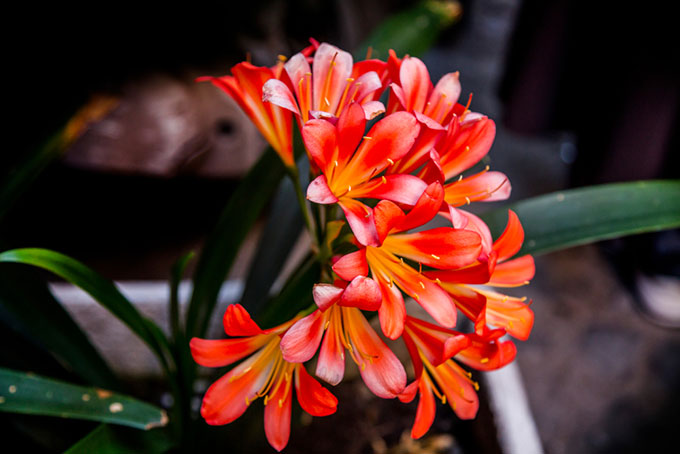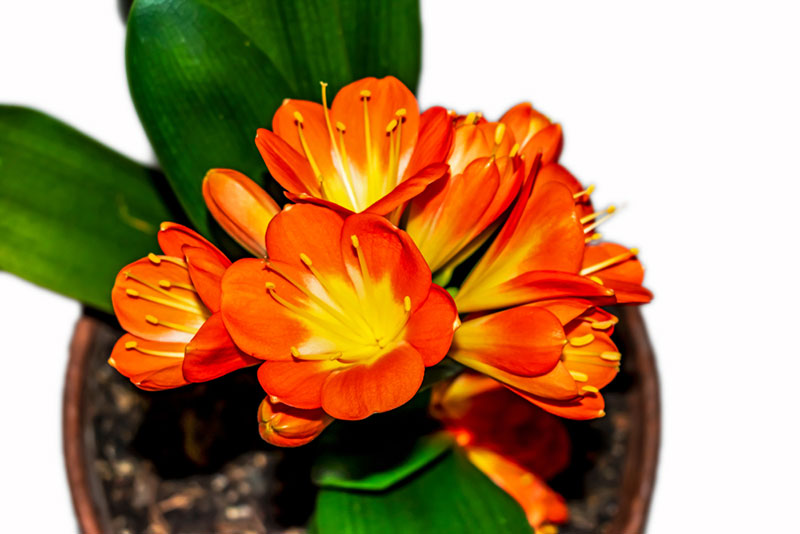Clivia is a beautiful flowering plant in the Amaryllis family which are native to South Africa. Their name was derived from Lady Charlotte Florentina Clive. They are gorgeous, visually desirable plants that produce trumpet-like flowers. The colors of the blossoms range from brilliant red to light orange.
| Origin: | South Africa |
| Common Names: | Natal lily or bush lily |
| Light: | Bright, but indirect light |
| Watering: | Water sparingly |
| Soil: | Rich and well-draining soil |
| Temperature: | Minimum 40° F | 4.4° C |
| Height: | up to 18 inches |
| Spread: | up to 12 inches |
Watering
The Clivia plant is very resilient and can handle time between watering. If it is watered too often, it will cause the roots to rot. A good rule of thumb is to water the plant once the soil becomes dry to the touch. The plant is much more sensitive to overwatering as opposed to not watering enough. Having them planted in a well-draining atmosphere will ensure the longevity of the plant.
Light and Room Temperature Requirements
Clivia plants can survive in most light conditions but they prefer moderately shaded areas. They do not thrive well in bright, direct sunlight for an extended period, but they do love well-lit areas. Clivia plants need to be kept at a comfortable temperature of 70 degrees during daylight hours. At night, 50 degrees provides a comfortable atmosphere. It can be damaging to the plant if the temperature conditions drop below 40 degrees. Direct sunlight can also cause the flowers and leaves to wither.
Soil
Clivia plants do best in very rich and well-draining soils, soilless mixes or a combination. Adding portions of peat moss and sand to the bottom of the pot help greatly as well. The two help the soil to drain better, preventing root rot. Since the plants are very sensitive to over-watering, it is essential to have well-draining soil.
Fertilizer
Clivia plants need to be fertilized in the spring just after blooming. Once you begin the fertilization process, you can do so monthly with a water-soluble, potassium-rich fertilizer. The mixture needs to be 20-20-20 at half the recommended strength. It is recommended you discontinue fertilizing over the colder months. It is advised you last fertilize around September and do not repeat until the following spring.
Helping Clivias Bloom
To help your Clivia plant bloom, it is beneficial to plant them in a small pot. It should be replanted roughly every three years. It is imperative to leave the plant to rest for approximately six weeks during the winter to ensure optimal blooms for the following spring. They typically bloom quite early, around the month of February.

Propagating
You can propagate your Clivia plants by offsetting and dividing the plants. Clivia plants are rootless when first offsetting and do not produce roots for three weeks. They are moderately difficult to propagate, and division is the method most recommended to plant owners.
Problems
Why do the leaves on my Clivia have brown patches?
If you notice the leaves on your Clivia plant have brown or bleached patches that could mean your plant is getting to much direct sun. Solution: Move your plant to a different spot out of direct sunlight.




